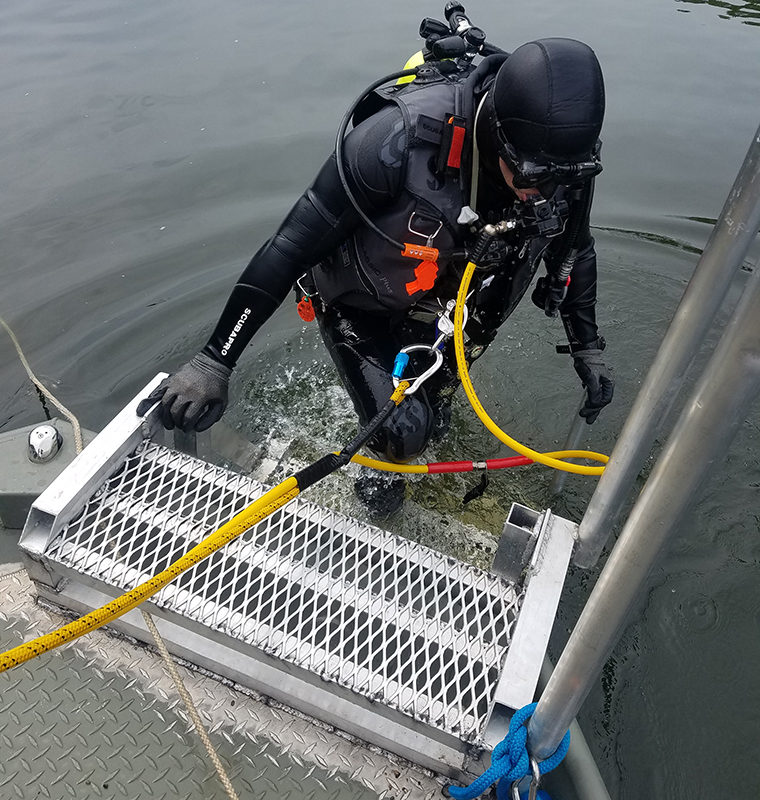Most days, Kevin Drews would rather be underwater than stuck in a meeting.
As the dive program manager for the U.S. Fish and Wildlife Service, he trains and oversees divers from the Great Lakes to Arkansas.
But on a cold February morning in 2023, Kevin was glad to be on dry land.
“I was sitting there drinking my coffee, and all of a sudden my arm went numb,” Kevin said. “It felt like I had slept on it wrong. I tried to walk it off and noticed my leg was acting oddly, too.”
He took an aspirin and drank some electrolytes. Feeling mostly returned to his arm, but Kevin was spooked.
“I was still able to use my arms, my hands, but they felt different and weaker than they had,” Kevin said. “It was such a subtle thing and something I'd never experienced before.”
Kevin decided to drive to the hospital. On the way, he called his wife, Sam, who urged him to pull over. She finished the drive to MU Health Care’s University Hospital ER, where doctors and nurses were concerned that Kevin, at 35, had just had a stroke.
“From the outside, Kevin didn't look sick, and a lot of stroke patients don't look sick from the outside,” said Brandi French, MD, a vascular neurologist and stroke expert at MU Health Care who was on call that day. “Brain health on the inside is a little different. And stroke doesn’t spare any age.”
As mid-Missouri's only Comprehensive Stroke Center, MU Health Care offers the highest level of stroke care, including advanced diagnostics and round-the-clock staffing of neuro-interventionalists who can reopen arteries and repair aneurysms.
In Kevin’s case, he had suffered a specific kind of stroke called a transient ischemic attack, or TIA. During a TIA, the body is able to either safely route blood around the clot or clear the clot naturally with limited tissue damage.
To doctors like French, a TIA is a serious event, on par with stroke, and a clear sign of increased risk of stroke in the future.
“The blessing of a TIA is the word transient, because stroke symptoms go away and everything appears fine,” French said. “The curse of a TIA is the word transient, because people will say, ‘The last time this happened to me, it all went away in 20 minutes or an hour.’ And every minute they’re experiencing stroke symptoms is potentially increased brain damage.”
Recognizing the early signs of stroke — and acting quickly — can make all the difference. That’s where the BE FAST acronym comes in:
- Balance loss or dizziness,
- Eyesight issues or blurred vision,
- Facial drooping, numbness or difficulty smiling,
- Arm weakness, numbness or inability to raise the arm overhead, or
- Slurred speech mean it’s
- Time to call 911
A stroke in a 35-year-old man is uncommon without an underlying cause like high blood pressure, cholesterol or diabetes. After ruling those out, Kevin’s care team dived back in to look for answers.
“The level of concern they expressed and the drive to keep following up on things until they found the cause, everyone wanted to take this so seriously,” Kevin said. “They knew what to look for and they kept pushing to find a cause. They didn’t just let this be a one-off thing.”
During his follow-up care, Kevin’s doctors found two key factors that likely contributed to the stroke.
He has a rare and mild blood disorder that increases clotting in his legs. And though a bubble test for heart defects didn’t reveal anything noteworthy, Kevin’s doctors also recommended a heart echocardiogram using an endoscopic probe. That test showed Kevin had a patent foramen ovale, or PFO.
During gestation, a baby gets most of its oxygenated blood from mom. Blood bypasses the baby’s lungs and enters the heart through a small opening, the PFO. This window closes naturally for most of us, but about 20-25% of people grow into adulthood with a PFO.
“A PFO can become important if a clot forms somewhere in the body — the legs are the most common place — because there are chemicals in the lungs that actually help break those clots up before they get to the rest of our body,” French said. “Those clots can bypass the lungs and then the heart pumps them into the body, and it’s painfully obvious when one of those clots gets sent to the brain.”

MU Health Care’s cardiology team used a catheter to permanently close Kevin’s atrial septum and make it less likely for blood clots to pass through his heart and into his bloodstream. A few months later, he was fully cleared to resume diving safely.
Kevin is grateful for that follow-up care for a lot of reasons. High on that list is how his health intersects with his job and the risks of diving underwater.
“Divers often get hurt or killed from having PFOs they don’t know about,” Kevin said. “It’s bad that this happened to me, but also way better than decompression sickness or getting a gas bubble in my brain. The fact that they were able to track this down and fix it, and I was able to get back to my job, is awesome.”




